You know I always tell you: you should do a tiny project first.
You know I always advise that you must accept that good things take time, work incrementally, and keep stacking the bricks.
Buuuut…sometimes you need to go big. You can build a lot of things nibble by nibble, but sometimes you need to take a great big honkin’ bite.
Sometimes you’re not building a good-sized wall out of bricks. Sometimes you’re building a cathedral.
The brand new 30x500 Launch Class is our cathedral.
After five years and 5 different versions, trying different things, different approaches, incremental improvements…Our system is complete. It is epic. Tremendous. Exacting.
It’s also metric ass-ton of work.
So how do two peeps (me + Alex) create something epic on a part time basis?
On Friday, Alex joined me for lunch and planning. We sat down together at our conference table, armed with coffee, a flip chart, paper and pens.
I took photos and scans to share with you!
Cuz there’s nothing sexier than a planning and specification process, amirite?
We started with the most crucial question:
1: What skills will our students need to have learned (and practiced) by the end of the second half of the class?
Cuz if you want people to actually learn stuff, you can’t just “tell them about the topic.” You need to start with their goals in mind.
Our students’ goal is to design, build, and launch their very first paying product to their very first sale.
In part 1, they learned how to read their customers’ minds, so they can start building their list — and their reputation — by giving their audience the help they need, by content marketing.
In part 2, they take all that research, knowledge, list building, and content to turn it into an unending stream of potential product concepts, and then pick one to make and launch.
Here is the complete list of skills our students still need to achieve those goals:
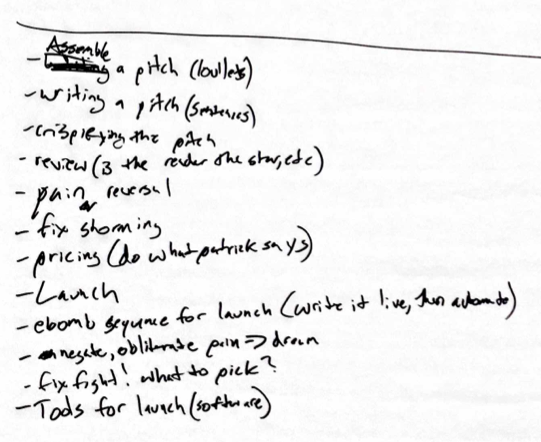
(You can tell it’s Alex’s handwriting because it’s illegible and spiky. Mine is illegible and swoopy. ;)
Students will need to understand, and feel confidently able to:
- assemble a pitch (in bullet form)
- write a pitch (full sentences)
- crisp-ify the pitch with vivid, concrete, and specific detail
- review and edit their pitches (the reader is the star, etc)
- reverse audience pain (to create what we call Dream)
- not just negate, but obliterate (these are steps in the process)
- fix storm (to brainstorm nearly infinite ways to solve a reader’s pain, aka all potential products of every type)
- fix fight! (which of all those potential products should you do…first?)
- price (basically, our rule is: Do what Patrick says.)
- run a simple but effective launch
- ebomb sequence for launch (the dramatic arc, how many emails, what should they say, etc)
- tools for launch (software etc)
(I reordered this from our written notes, obv!)
Were we ready to start then? Nope!
But wait…there’s more!
2: What’s the format?
So we’ve got this here list of end results:
“By the end of this class, you will achieve A, B and C. Because you’ll know how to X, Y, and Z!”
How do we, you know, deliver those end results for the customer?
Cuz it’s not about downloading the information to their brains.
None of these bullet items can exist in a vacuum. Even with an outline, we can’t just go willy-nilly writing “about” things. Or coding “a feature.”
You gotta know how the whole thing hangs together, how it operates, how the customer experiences it, and why.
An outline says what…your customer’s end goals say how, when, where, and in what format.
Back in the spring, we really busted our asses on Part 1. We couldn’t just sit down with an outline and start making lessons, no no.
First, we had to design (and test!) the entire structure of the class. The rhythm, the flow, the repetition.
After years of experience, research, and way too much thinking, this was the format we settled on:
- Problem
- Cold exercise (“how would you do this?”)
- Demonstration of the better way (and reasoning, too)
- Warm exercise (“now you know, try it…” with virtual hot seat and rubric for self-review)
- Expert’s examples and discussion
- Problem…rinse and repeat
So now we had the what — the list of skills.
We had the how - the format that’ll get the reader from “not having this skill at all” to “executing with this skill.”
What’s next?
3: Storyboard everything. Yes, everything.
A huge project isn’t just a small project times a hundred.
You can break down a huge project into tiny projects, but there’s a bit more to it than that. There are emergent properties that come with size and scope.
When you’re building a cathedral, you can’t just make a pile of generic rectangular bricks. They have to interlock.
The absolute worst time to figure out how to fit the pieces together is when you’re making the pieces.
You need to follow a grand plan.
So before we jumped into slides, exercises, recording, editing…Alex and I sat down and storyboarded every step.
I learned to storyboard as an interface designer. But I apply it to everything - blog posts, workshops, books, talks. So-called “static content.”
Here’s a little secret that great authors know, and bad authors never learn:
Even if the “content” is static — the customer isn’t. The customer moves through it. It’s an experience.
So you storyboard it, just like it’s an interactive experience. Because…duh…it is.
Take a gander at our storyboard for alllllll the final lessons in 30x500.
Complete with notes on content, how to repeat our frameworks/metaphors, even some doodles for individual slides:
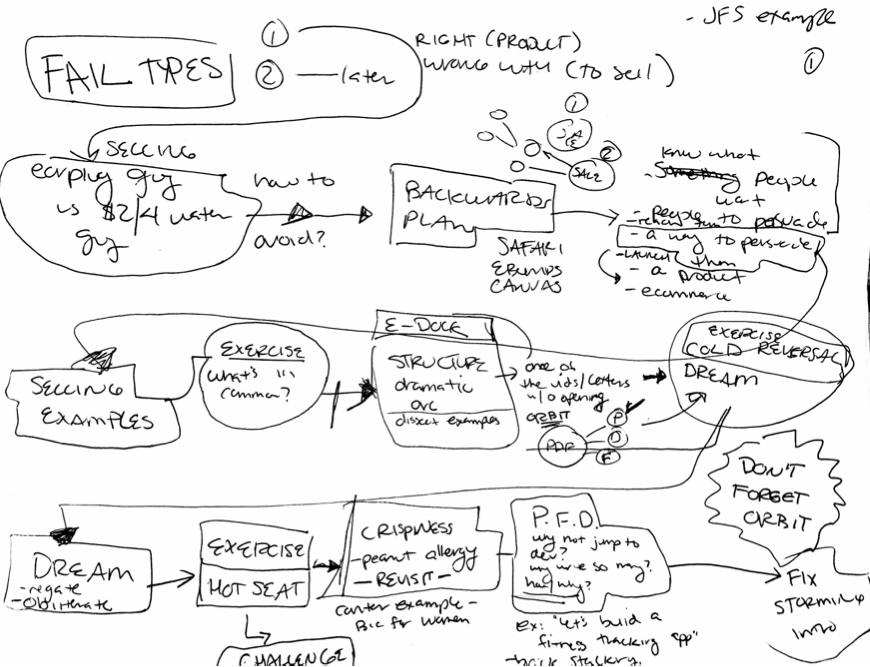
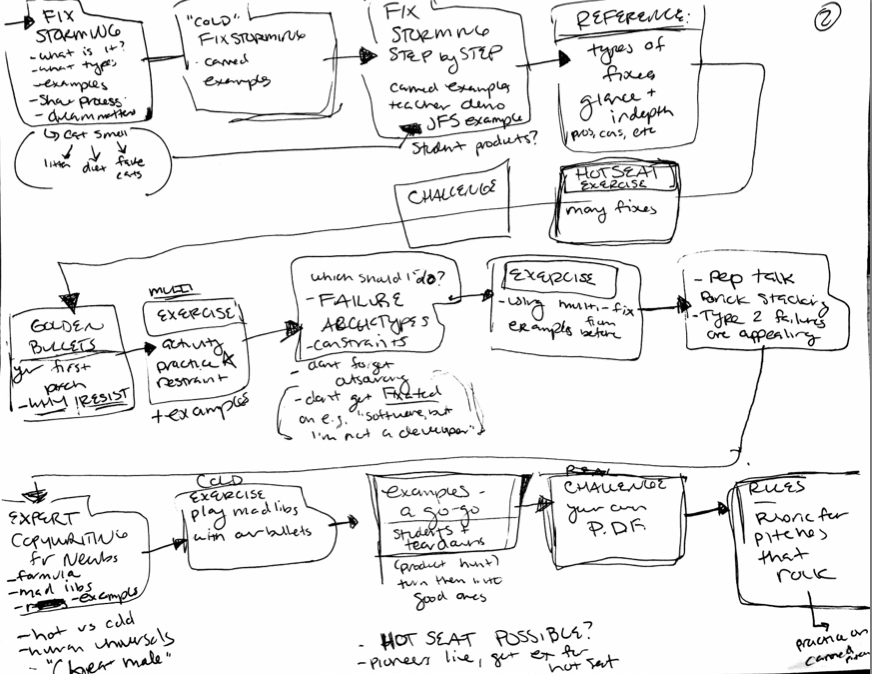
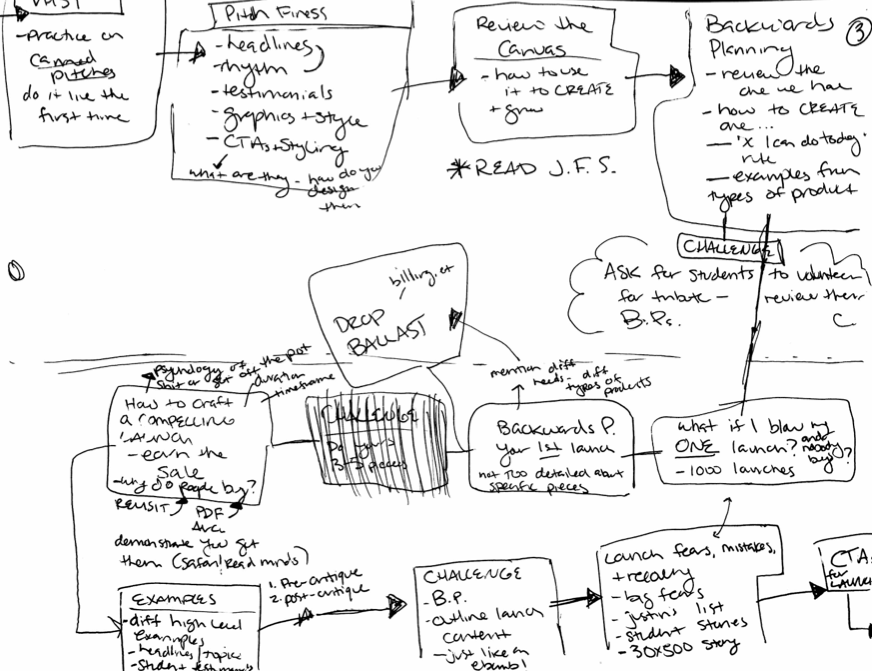
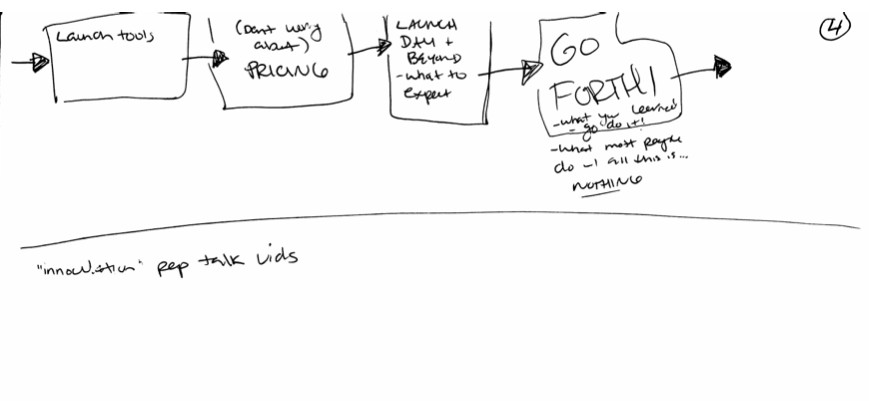
There. Our whole path, stretched out in front of us.
What’s the next step? It’s clear.
What’s done look like? It’s clear.
How will our students work their way through this “content”? It’s clear.
How many exercises and virtual hot seats? It’s clear.
Yay, clarity! It makes the immense task ahead knowable, and therefore doable.
Though we’re not quite done yet…
4: Turn the outline and plan into to-do’s
Our next steps will turn all this clarity into actionable to-do’s.
In my next post, I’ll show you how we…
- turn this into a set of to-do’s
- create a schedule
- structure a workflow so both Alex and I know who’s doing what, when, and where it’s at in the process
How do you make your first sale?
Follow our FREE roadmap from $0 to $10k and start your product business one small, achievable win at a time.
When you subscribe, you’ll also get biz advice, design rants, and stories from the trenches once a week (or so). We respect your email privacy.
P.S. Naturally, you can learn all about this process (and the others!) in my book, Just F$#*ing Ship.

